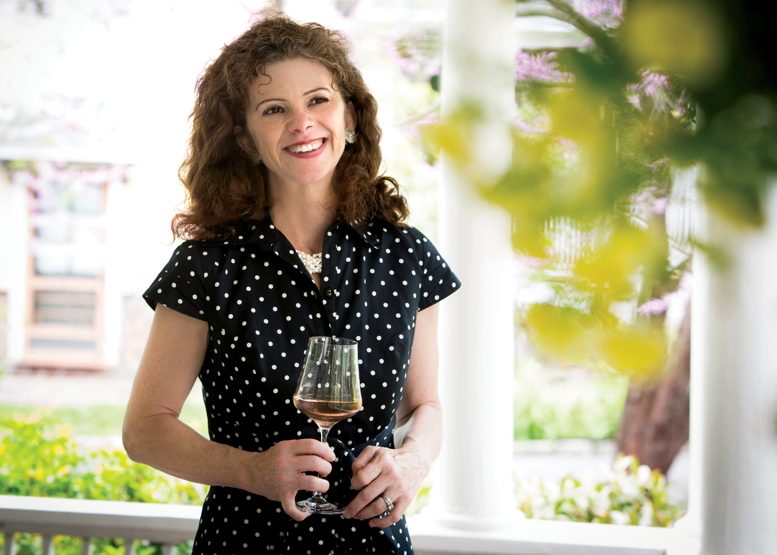
Lettie Teague would like a word with us Jerseyans—a group that includes her, since she moved from the North Fork of Long Island to Montclair in 2012. She says we don’t appreciate our BYOs. “If you come from New York,” she says, “you realize what a phenomenal privilege this is.”
Yes, she concedes that Jersey’s law restricting restaurant liquor licenses to one for every 3,000 residents in a town drives the cost of a license to what she calls “insane” levels. In fact, she devoted one of her Wall Street Journal wine columns to that subject shortly after moving here to marry a lifelong Jerseyan. “Roger [her husband] said, ‘Do we have to tip as if there were a bottle of wine on the bill?’” “Absolutely!” was her answer.
Why? The server still has to provide glasses, open (and perhaps chill) the bottle, pour the wine (without spilling) and refill discretely as needed. That’s a lot of extra work. Consequently, Teague sums up, “I always tip as if there were anywhere from a $20 to a $40 bottle of wine on the bill.”
Think about that next time you hand the server your bottle. Teague’s sensible stance says a lot about her. How many big-time wine critics—and Teague, winner of three James Beard Journalism Awards, including the MFK Fisher Distinguished Writing Award, is definitely big-time—would bother to note, let alone do something about, the plight of under-tipped BYO servers?
In her new book, Wine in Words: Notes For Better Drinking (Rizzoli, $29.95), Teague is liberal about certain things (“I think that the bond between food and wine is pretty elastic and there aren’t many matches that are downright terrible”) and testy about others, like that bromide for the uncertain, “Drink what you like.” In a Wine in Words essay titled, “The Biggest Wine Myth,” she counters, “While wine drinking should always be pleasurable, it shouldn’t be the same pleasure experienced the same way over and over again.” Her advice: “Drink what you don’t know.…The more you experiment, the greater your credibility as a drinker when you declare, ‘I know what I like.’”
Teague’s prose, like a memorable wine, is brisk, concentrated, juicy and refreshing. She labels terroir “the most overused word in wine,” and declares that less than 5 percent of all wines improve with time: “In fact, the ‘drinking window’ for almost all the wine produced in the world is the same as the one for beer: right away.”
Wide-ranging and iconoclastic, Teague bemoans the wine world’s fixation on 100-point scores and cheers the humble screw cap, thanking New Zealand for championing this simple device that eliminates spoilage by bad corks and helps half-empty bottles stay fresh longer. Nowadays, she writes, “some of the best wines in [Germany, Austria, Australia and the United States] are bottled under screw caps.”
Defending Chilean wines against their usual faint-praise dismissal as “cheerful and cheap,” she notes that many are “ambitious and sound…[displaying] remarkable character and historical significance and—yes—value, too.” The problem for Chile, she proposes, is that, compared to iconic words like “Napa” and “Burgundy,” the names of its important regions “are harder to pronounce and have too many vowels.”
Funny is a quality rarely associated with wine criticism, but Teague can make you smile. Moreover, she wields her wit with purpose. The pithy essays in Wine in Words, her third book, include one called, “Lost in Translation.” In it, she returns to consumers’ apparent need for readability over drinkability. “German Riesling,” she writes, “is one of the most profound wines in the world—sommeliers everywhere sing its praises and its versatility with food.” The problem is that “the names of most German Rieslings aren’t easy to spell or to pronounce…Unlike the French word cru or the Italian riserva, which look so alluring on labels, German wine words look downright scary. (All those umlauts.)”
Born in Indiana, raised there, in North Carolina and Ohio, Teague was exposed to wine glasses at an early age. That’s not a misprint. “My father designed and marketed glassware,” she says. “He paid more attention to the glasses than to the wine. We had really nice wine glasses from all over the world, and not very good wine.”
She didn’t encounter great wine until she spent six months in Dublin. Again, not a misprint. In 1982, her junior year at Ohio’s Kenyon College, she studied in Dublin and was housed with the family of Ireland’s leading wine merchant, Peter Dunne of Mitchell & Son. “Peter used to bring wine home at night and talk about it,” she says. “His wife, Anne, was a great cook, so I had this absolute revelation about what the food-and-wine experience could be.”
After college, she settled in New York City and started as a retail wine salesperson. In 1995, she got a job as food, wine and books editor of Diversions, a short-lived Hearst magazine for physicians. Two years later, she parlayed that into a job as wine editor of Food & Wine, where she began writing a column and winning awards. The Wall Street Journal hired her in 2010.
Now her 800-word On Wine column runs every Friday in the New York section of the Journal, and (with no piggybacking) her 1,200-word column for the national edition runs three Saturdays a month. The essays in Wine in Words, she points out, are not column retreads. That adds up, I tell her, to a lot of production.
“Thank you for noticing!” she says with a laugh as bracing and effervescent as champagne—which, by the way, she recommends as a fail-safe choice when giving wine as a gift. (Magnums make a big impression, too, she writes. If giving red, cabernet is the grape with max cachet.)
But back to her productivity. “It’s like being on a hamster wheel. I’m caffeinated, well caffeinated,” she says, laughing. “My motto is, ‘anxiety is the key to success.’ Always be worrying. Complacency of any sort is the beginning of the end.”



